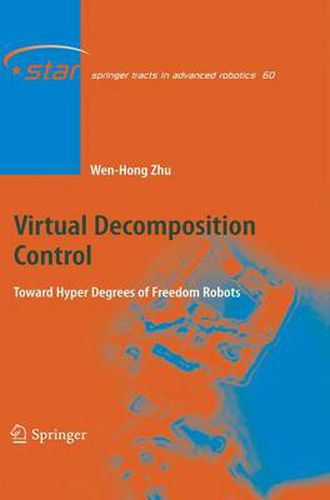Readings Newsletter
Become a Readings Member to make your shopping experience even easier.
Sign in or sign up for free!
You’re not far away from qualifying for FREE standard shipping within Australia
You’ve qualified for FREE standard shipping within Australia
The cart is loading…






This title is printed to order. This book may have been self-published. If so, we cannot guarantee the quality of the content. In the main most books will have gone through the editing process however some may not. We therefore suggest that you be aware of this before ordering this book. If in doubt check either the author or publisher’s details as we are unable to accept any returns unless they are faulty. Please contact us if you have any questions.
Driven by the need to achieve superior control performances for robots with hyper degrees of freedom, the virtual decomposition control approach is thoroughly presented in this book. This approach uses subsystem (such as links and joints of a complex robot) dynamics to conduct control design, while guaranteeing the stability and convergence of the entire complex robot without compromising the rigorousness of the system analysis. The central concept of this approach is the definition of the virtual stability. The stability of the entire complex robot is mathematically equivalent to the virtual stability of every subsystem. This fact allows us to convert a large problem to a few simple problems with mathematical certainty.
This book comprises fourteen chapters. The first five chapters form the foundation of this approach. The remaining nine chapters are relatively independent. Starting from Chapter 6, each chapter deals with a particular type of systems including motor/transmission assemblies, hydraulic robots, coordinated multiple robots, space robots, humanoid robots, adaptive teleoperation, and modular robot manipulators. At the end, the extensions of this approach to distributed-parameter systems and to electrical circuits are given, paving the way for other applications to follow.
This book is intended for practitioners, researchers, and graduate students who have acquired fundamental knowledge on robotics and control systems and have been committed to achieving the best control performances on complex robotics systems and beyond.
$9.00 standard shipping within Australia
FREE standard shipping within Australia for orders over $100.00
Express & International shipping calculated at checkout
This title is printed to order. This book may have been self-published. If so, we cannot guarantee the quality of the content. In the main most books will have gone through the editing process however some may not. We therefore suggest that you be aware of this before ordering this book. If in doubt check either the author or publisher’s details as we are unable to accept any returns unless they are faulty. Please contact us if you have any questions.
Driven by the need to achieve superior control performances for robots with hyper degrees of freedom, the virtual decomposition control approach is thoroughly presented in this book. This approach uses subsystem (such as links and joints of a complex robot) dynamics to conduct control design, while guaranteeing the stability and convergence of the entire complex robot without compromising the rigorousness of the system analysis. The central concept of this approach is the definition of the virtual stability. The stability of the entire complex robot is mathematically equivalent to the virtual stability of every subsystem. This fact allows us to convert a large problem to a few simple problems with mathematical certainty.
This book comprises fourteen chapters. The first five chapters form the foundation of this approach. The remaining nine chapters are relatively independent. Starting from Chapter 6, each chapter deals with a particular type of systems including motor/transmission assemblies, hydraulic robots, coordinated multiple robots, space robots, humanoid robots, adaptive teleoperation, and modular robot manipulators. At the end, the extensions of this approach to distributed-parameter systems and to electrical circuits are given, paving the way for other applications to follow.
This book is intended for practitioners, researchers, and graduate students who have acquired fundamental knowledge on robotics and control systems and have been committed to achieving the best control performances on complex robotics systems and beyond.